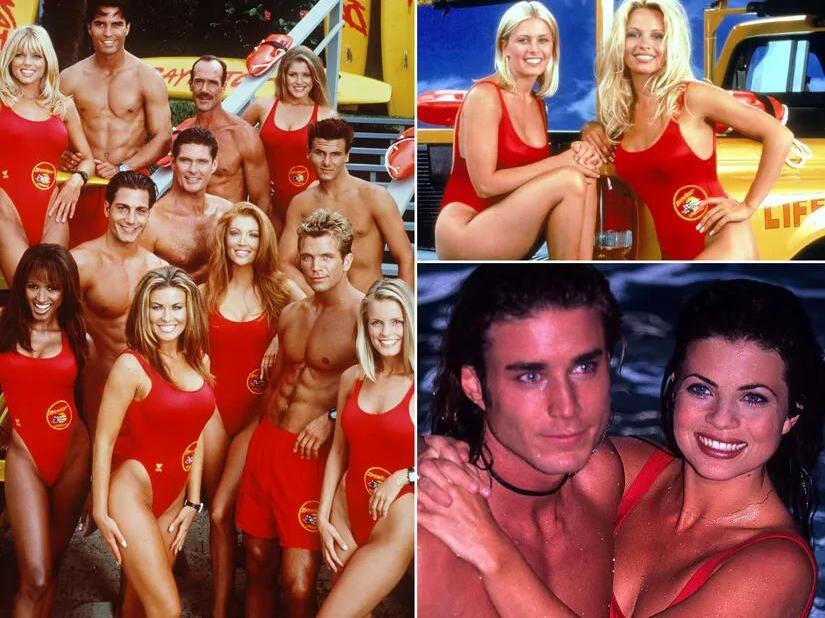Physical Address
304 North Cardinal St.
Dorchester Center, MA 02124
Physical Address
304 North Cardinal St.
Dorchester Center, MA 02124

The stars of Baywatch dive into the real stories behind the ’90s series in the ABC News docuseries After Baywatch: Moment in the Sun, which sheds light on TV’s most famous lifeguards.
Show star Nicole Eggert expressed that previous documentaries on the show lacked “real truth to people’s journey.” Now, she believes the time has come to unveil the saga of Baywatch. The new docuseries brings to light topics of hookups, racism, addiction, body image, secrets, and even Pamela Anderson’s volatile relationship with Tommy Lee.
The docuseries begins by exploring the on-set romances. Initially, Billy Warlock and Erika Eleniak had “platonically flirtatious” vibes. However, their chemistry evolved into a relationship once they ended their previous ones after the first season. Other cast members, like Alexandra Paul, revealed secret relationships, while David Chokachi hinted at the intense environment on the beach, ripe for romances.
Before Eleniak was cast, NBC didn’t want her because she had posed for Playboy. Eleniak called out the hypocrisy, and with the help of the show’s creators, she secured her role. Carmen Electra, a fellow Playboy model, remarked on the number of co-stars with Playboy backgrounds.
The show, initially canceled by NBC, found revival and tremendous success in first-run syndication. With the revival, new cast members joined, including Jeremy Jackson as Hasselhoff’s on-screen son. Leonardo DiCaprio had auditioned for this role but lost to the younger Jackson, who reportedly impressed everyone in his audition.
Renowned surfer Kelly Slater, part of the third season, regretted his stint. He criticized the show’s writing, recalling the absurdity of facing a giant octopus that stole surfboards. Despite his initial hope, he wished obscurity for his episodes.
While Baywatch had immense success, its budget was notably thin. Alexandra Paul remarked on the low budget compared to other contemporary shows. They frequently relied on montages to fill episode gaps. Cast members like Erika Eleniak and Billy Warlock even took pay cuts post the show’s cancellation and revival. They were reportedly paid $3,500 per episode, a sum Eggert struggled with post-tax.
The infamous red swimsuits weren’t the only thing that shrank; the swimsuits became skimpier over time, making some cast members uncomfortable. Eleniak highlighted plunging necklines and increased sexual focus in the show’s visual aesthetics. Furthermore, cast contracts included clauses about maintaining a specific weight range, emphasizing the extraordinary body image pressures on actresses.
Paget Brewster reminisced about her distinct body but found empowerment in embracing her natural self. Nicole Eggert shared how the show influenced girls to have bigger lips and boobs, leading her to modify her body at 20.
Men on the show, like David Chokachi and Jeremy Jackson, also felt the weight of physical expectations. Chokachi humorously discussed his pre-filming ritual to enhance his appearance in swim trunks. For Jackson, puberty on such a show invoked unique challenges.
The casting of Pamela Anderson added to Baywatch’s allure. Introduced by Hugh Hefner, Anderson’s auditions were memorable and eventually successful. David Hasselhoff initially opposed her casting but was overruled, paving the way for Anderson’s lasting impact on the show.
Anderson’s turbulent relationship with Tommy Lee complicated her time on Baywatch. Issues of jealousy often surfaced, affecting filming dynamics. The infamous leak of their private tape further reshaped public perceptions and indirectly boosted the show’s ratings.
Baywatch often faced criticism for its lack of diversity. Ingrid Walters, one of the few non-white stars, shared that the show often received criticism for its overwhelmingly white cast. Gregory Allan Williams, part of the original cast, believed his appearance was often for comic relief, causing moments of personal reflection on his role.
Williams recounted being excluded from a major cast photoshoot, underscoring the pervasive exclusion. Alexandra Paul made efforts to push for more balanced representation in casting but found mixed results.
For Jaason Simmons, a gay actor who kept his sexuality private due to industry pressures, maintaining secrecy was taxing. Paul often acted as his “beard,” to keep him safe from inevitable industry prejudices.
Jeremy Jackson discussed his struggles growing up on set. Post his tenure on the show, he fell into substance abuse, spiraling down a dark path that led him to quit the show, face multiple challenges, and even incarceration. His co-stars provided unwavering support during his lowest moments, illustrating the strong bonds formed during the series.
Nicole Eggert’s recent battle with breast cancer and Michael Newman’s diagnosis of Parkinson’s were also highlighted, showing both their resilience and continuing battles.
Post Baywatch, many stars faced challenges shedding their roles to be taken seriously in subsequent projects. Erika Eleniak and Kelly Packard grappled with their Baywatch legacy affecting new opportunities. Eleniak spoke candidly about missed career opportunities due to self-doubt stemming from her time on the show.
While some, like Billy Warlock and Michael Bergin, transitioned to quieter lifestyles, they carry their Baywatch legacy differently today.
After Baywatch: Moment in the Sun is now streaming on Hulu.
Source: ABC News, Hulu



